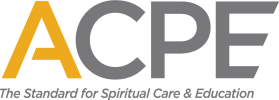This page is the same information as the page: Certified Educator CPE in the Accreditation Manual.
Hybrid Model for CEC Programs #1
Requirements
- A program must be accredited for Certified Educator CPE.
- If the proposed site is not accredited, it must first apply for and be granted provisional accreditation before a CEC may function there.
- It needs to be clear that the ACPE Certified Educator is running the unit and is responsible for education and evaluations. The role of the CEC will be developed in accordance with the Progressive Autonomy in Educating Under Supervision that is outlined in the Certification Manual.
- While the group is regularly meeting in person and the ACPE Certified Educator is often joining virtually, it is also expected that the ACPE Certified Educator have a physical, in-person presence at the site with the students at various times during the unit. The number and length of each in person visit shall be determined by the ACPE Certified Educator with special attention to the developing role of the CEC, i.e. more in person visits at the start of the CEC’s process, when a CEC is in Phase IA, with a gradual shift as the CEC advances through to Phase IB, and then on to Phase II of the Certification Process. It is essential that the ACPE Certified Educator function as the educator of record for the unit.
- The design of the CEC program, including how decisions are made related to the physical in-person time of the educator, should be documented in the program’s accreditation portfolio. Special attention should be given to the ensuring that the role of the CEC does not grow too fast too soon, but rather it should grow when the CEC has demonstrated readiness to move forward.
- A program must include additional items in their portfolios:
- Standard 1, Indicator E: Policy and utilization for video conferencing and how it serves to fulfill educational goals. Be sure to explicitly explain how these policies are serving the hybrid CEC program.
- Standard 5, Indicator D: Explain the role of the CEC in the greater institution. Do they have responsibilities outside of being a CEC? If so, what are they and how do they impact their ability to move through the CEC process? What support does the center provide for the CEC?
- Accredited program and ACPE Certified Educators who are utilizing this model must consult with their assigned Accreditation Commissioner and the CEC’s Certification Commission Reviewer to ensure that both the program and the CEC are together on the path for success. These check-ins should occur when the CEC transitions from one phase of the process to the next or when the CEC moves from one program to another.
Hybrid Model for CEC Programs #2
- A program must be accredited for Certified Educator CPE.
- If the proposed site is not accredited, it must first apply for and be granted provisional accreditation before a CEC may function there.
- It needs to be clear that the ACPE Certified Educator is running the unit and is responsible for education and evaluations. The role of the CEC will be developed in accordance with the Progressive Autonomy in Educating Under Supervision that is outlined in the Certification Manual.
- While the group is regularly meeting in person and the ACPE Certified Educator is often joining virtually, it is also expected that the ACPE Certified Educator have a physical, in-person presence at the site with the students at various times during the unit. The number and length of each in person visit shall be determined by the ACPE Certified Educator with special attention to the developing role of the CEC, i.e. more in person visits at the start of the CEC’s process, when a CEC is in Phase IA, with a gradual shift as the CEC advances through to Phase IB, and then on to Phase II of the Certification Process. It is essential that the ACPE Certified Educator function as the educator of record for the unit.
- The following principles shall apply to designing the in-person elements of the program:
- CECs must have multiple opportunities within each unit for in-person interactions with the ACPE Certified Educator, the students, and the preceptors.
- ACPE Certified Educators and CECs are relational with each other in both the online and in-person environments. Hybrid programs should ensure that there are ample opportunities in both environments to help CECs to grow fully into their future roles as ACPE Certified educators.
- The design of the CEC program, including how decisions are made related to the physical in-person time of the educator, should be documented in the program’s accreditation portfolio. Special attention should be given to the ensuring that the role of the CEC does not grow too fast too soon, but rather it should grow when the CEC has demonstrated readiness to move forward.
- A program must include additional items in their portfolios:
- Standard 1, Indicator E: Policy and utilization for video conferencing and how it serves to fulfill educational goals. Be sure to explicitly explain how these policies are serving the hybrid CEC program.
- Standard 5, Indicator D: Explain the role of the CEC in the greater institution. Do they have responsibilities outside of being a CEC? If so, what are they and how do they impact their ability to move through the CEC process? What support does the center provide for the CEC?
- Accredited program and ACPE Certified Educators who are utilizing this model must consult with their assigned Accreditation Commissioner and the CEC’s Certification Commission Reviewer to ensure that both the program and the CEC are together on the path for success. These check-ins should occur when the CEC transitions from one phase of the process to the next or when the CEC moves from one program to another.


